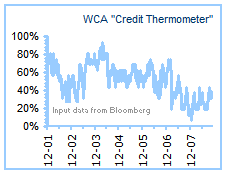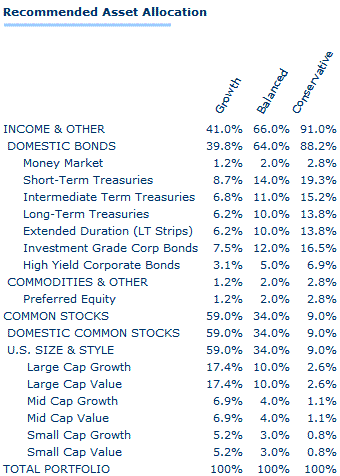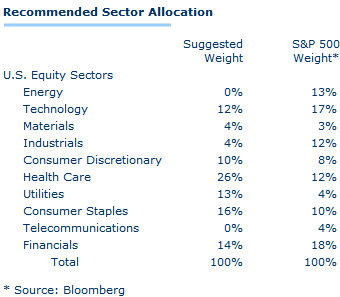Household Credit Turns Negative
Never before has household borrowing contracted by so much
in a single quarter. Today, the Federal Reserve
released its third quarter Flow of Funds Report, and it
showed that U.S. households contracted borrowing by $117
billion during the quarter. Most of that came from a
$259 billion contraction in home mortgage net new borrowing.
In other words, the amount of new money and credit entering
into the system from the largest segment of the economy has
not only stopped, but has gone into reverse. A
negative number in the overall household category has never
been recorded throughout the Federal Reserve's history of
keeping the flow of funds data. The negative $117
billion in net new borrowing (perhaps better called net
savings) compares to the $1.4 trillion of annualized
borrowing that was occurring during the peak of the housing
bubble in the second quarter of 2006.
We have spoken at length about the relationship between
credit and money creation, the effect on prices, and the
hard dollar environment that we believe we find ourselves in
at this time. This contraction in credit can also be
seen by foreigners whose net new borrowing fell by the
largest amount ever -- over $500 billion. The Federal
Government, largely through the expansion of the Federal
Reserve's balance sheet, provided a massive offset to credit
by growing net borrowings at an annualized rate of $2,078
billion -- a massive 39% annualized increase for the
quarter.
This matters because, in order for monetary policy to be
successful in fighting recession, the Fed must increase the
money supply by giving banks and individuals more money.
They do this in a variety of ways, but the most common
approach is lowering interest rates while simultaneously
infusing banks' balance sheets with cash. Those
dollars must then be lent out to individuals and businesses
that make investments which have a multiplier effect on the
economy, thus creating expenditures, revenue, jobs, and some
upward pressure on prices.
What the Flow of Funds data shows us is that the normal
credit cycle (which usually troughs out at a two-thirds
drop-off in net new credit) is not what is happening this
cycle. The lack of willingness by banks to lend (to
protect their capital position), coupled with individuals'
and businesses' lack of interest in borrowing (possibly
because home values remain elevated or because leverage
ratios are uncomfortably high), prevent new credit and money
from being created. This lack of credit creation is
contributing to downward pressure on both asset prices and
consumer prices and exacerbating both recovery and
de-leveraging efforts.
The programmatic response by government to engage in
deficit-financed spending during recessions is well
entrenched. Thus, we expect to see further efforts for
the government to step up borrowing and spending in the
absence of private-sector initiatives. The data we now
have shows that government borrowing relating to the various
rescue efforts is creating credit, but much of that credit
is remaining within the banking system itself to replace
capital that is being written off. To date,
mortgage-related write-offs in the United States has
exceeded $600 billion, and globally, those write-offs are
approaching $1 Trillion, according to Bloomberg.
Overall rescue efforts, including new guarantees, credit
facilities, equity purchases, and loans to financial firms,
are nearing $8 Trillion in size. Granted, one hopes
that most of those guarantees (which do not include the now
explicit guarantees of packaged Fannie and Freddie debt)
will not require payment by the government, and not all the
loans and equity injections will be without some eventual
return of principal. We have seen the Federal
Reserve's balance sheet swell to $2 Trillion (from $1
Trillion) in recent weeks, because the losses incurred by
the financial system have been in excess of what the banking
system could absorb without government assistance. On
balance, these efforts have not been viewed as conclusive
victories, as many of the credit spreads we follow remain
very elevated and are rising while full-faith-and-credit
government bonds and bills are signaling that extreme stress
remains despite the efforts of the Federal Reserve and
Treasury. We continue to monitor for signs of credit
improvement as measured by the WCA "Credit Thermometer," and
while some initial improvement followed the announcement of
the TARP program last fall, the trends have once again begun
to gradually move in the wrong direction. This remains
a troubling sign that suggests continued strain in the
banking system. It is this system which remains
reluctant to lend despite the government efforts to initiate
a program of expansionary monetary policy.

The re-pricing of risk in financial markets has been a positive start.
Credit spreads and equity risk premia are all much higher
than before the process of debt-deflation began. Home
prices have fallen by roughly 20%, which makes that asset
more affordable than it had been. These adjustments
are creating value in the marketplace for private capital
and eventually could yield better returns for risk-taking
investors. In the meantime, falling asset prices are
making it difficult for households and financial
institutions to reduce debt and balance sheet leverage.
This phenomenon can be clearly seen by looking at the
interplay of equity and debt on the U.S. household balance
sheet. Because asset prices (home prices and stock
market values) are falling faster than debt can be paid off,
the official tally for U.S. household equity has contracted
by $7.1 trillion in the last four quarters. By
comparison, the bursting of the technology stock bubble
resulted in only a $4.1 trillion loss of household equity.
While debt and leverage remains the "Achilles heel" of
household finances, the collective efforts to liquidate
assets to pay down debt at all levels of the economy are
exacerbating the leverage problem as the debt-to-equity
ratio for households rises sharply from 21% of equity to 26%
of equity in a little over a year. Falling employment,
wage concessions, and further erosion in asset prices could
make matters worse over the near term and pose additional
risks to lenders and financial institutions exposed to weak
creditors.
While we clearly see that markets have corrected by historic
proportions, we are concerned that the monetary transmission
mechanisms through which expansionary monetary policy are
implemented are not functioning properly at this time.
Without such tools, it is difficult to see a rapid recovery
from this recession as we have seen in past cycles.
The data we received today in the form of the Flow of Funds
Report from the Federal Reserve serves as a sobering
reminder of the challenges we face on the road to eventual
recovery.
Therefore, we continue to await signs of improvement in financial market
conditions before committing any additional risk capital to
our tactical asset allocation portfolios. Our current
portfolio continues to emphasize high grade and liquid assets, including
government bonds and bills.

 |
Past Commentaries
November 21, 2008
Credit: Don't Want It... Can't Get It...
More
September 24, 2008
Downgrading Outlook Based on Credit Freeze
More
September 15, 2008
Equity Markets Stumble on Lehman, Merrill, and AIG
More
September 9, 2008
No Change In Strategy On GSE Action
More
July 31, 2008
Quick Take on GDP Report
More
July 21, 2008
Valuation Are Better, But Markets Are Not Out of the
Woods
More
May 20, 2008
Buy the Dips
More
March 10, 2008
Investing During Recession
More
January 22, 2008
Global Sell-off
More
December 27, 2007
Outlook 2008
More
December 7, 2007
NBER President Raises Recession Concerns
More
November 28, 2007
Equity Risk Heightened - Allocation Remains Defensive
More
September 25, 2007
After the Rate Cut
More
July 30, 2007
The Case For Growth
More
June 15, 2007
Data Affirms Tactical Asset Allocation Posture
More
March 19, 2007
Cutting Earnings And Equity Target
More
| |
To unsubscribe, please click here.
Company Name, Address and Contact Details
The information contained herein has been prepared from sources believed to be
reliable but is not guaranteed by us and is not a complete summary or statement
of all available data, nor is it considered an offer to buy or sell any
securities referred to herein. Opinions expressed are subject to change without
notice and do not take into account the particular investment objectives,
financial situation, or needs of individual investors. There is no guarantee
that the figures or opinions forecasted in this report will be realized or
achieved. Employees of Stifel, Nicolaus & Company, Incorporated or its
affiliates may, at times, release written or oral commentary, technical
analysis, or trading strategies that differ from the opinions expressed within.
Past performance is no guarantee of future results.
Indices are unmanaged, and you cannot invest directly in an index.
There are special
considerations associated with international investing, including the risk of
currency fluctuations and political and economic events. Investing in emerging
markets may involve greater risk and volatility than investing in more developed
countries. Due to their narrow focus, sector-based investments typically exhibit
greater volatility. Small company stocks are typically more volatile and carry
additional risks, since smaller companies generally are not as well established
as larger companies. Property values can fall due to environmental, economic, or
other reasons, and changes in interest rates can negatively impact the
performance of real estate companies. When investing in bonds, it is important
to note that as interest rates rise, bond prices will fall. High-yield bonds
have greater credit risk than higher quality bonds. The risk of loss in trading
commodities and futures can be substantial. You should therefore carefully
consider whether such trading is suitable for you in light of your financial
condition. The high degree of leverage that is often obtainable in commodity
trading can work against you as well as for you. The use of leverage can lead to
large losses as well as gains.
Stifel, Nicolaus & Company, Incorporated | Member SIPC & NYSE |
www.stifel.com |